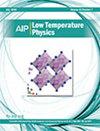Nonlinear phenomena in charge transport properties of a hole-doped organic spin-liquid compound
IF 0.6
4区 物理与天体物理
Q4 PHYSICS, APPLIED
引用次数: 0
Abstract
The nonlinear electric conductivity of κ-(BEDT-TTF)4Hg2.89Br8, which is known as a hole-doped spin liquid, has been observed by single crystal transport measurements using dc and ac excitations. This compound is known as a charge transfer complex with strong magnetic fluctuations accompanied by electron mass enhancement at ambient pressure. We discuss the nonlinear dc conductivity drastically emerging below 100 K. We also performed ac impedance measurements of this compound and compared the results with those of a typical dimer-Mott compound of deuterated κ-(d8-BEDT-TTF)2Cu[N(CN)2]Br, located just near the Mott boundary. The analyses of the Nyquist plots of κ-(d8-BEDT-TTF)2Cu[N(CN)2]Br and κ-(BEDT-TTF)4Hg2.89Br8 reveal qualitatively different features. The former shows a behavior pertinent to the inhomogeneous distribution of domains due to a mixing of metal and insulating phases, taking into account the influence of the proximity effect, while the doped spin liquid has a distinct semicircle-type frequency dependence in its Nyquist plot in the whole temperature range studied. We conclude that the nonlinear conductivity is intrinsically peculiar to the doped dimer Mott system, where the charge degrees of freedom dominate the itinerancy. We attribute the anomalous features, such as non-Fermi liquid behavior, heat capacity enhancement, and strong antiferromagnetic fluctuations in κ-(BEDT-TTF)4Hg2.89Br8, to a kind of charge confinement effect retained in the hole-doped spin-liquid state.掺杂空穴的有机自旋液态化合物电荷传输特性中的非线性现象
通过使用直流和交流激励进行单晶传输测量,观察到了κ-(BEDT-TTF)4Hg2.89Br8 的非线性电导率。众所周知,这种化合物是一种电荷转移复合物,在环境压力下具有强磁波动和电子质量增强。我们还对该化合物进行了交流阻抗测量,并将测量结果与位于莫特边界附近的典型二聚-莫特化合物(氚化 κ-(d8-BEDT-TTF)2Cu[N(CN)2]Br)的测量结果进行了比较。对κ-(d8-BEDT-TTF)2Cu[N(CN)2]Br 和 κ-(BEDT-TTF)4Hg2.89Br8的奈奎斯特图的分析揭示了质的不同特征。考虑到邻近效应的影响,前者显示出与金属相和绝缘相混合导致的畴不均匀分布有关的行为,而掺杂自旋液体在整个研究温度范围内的奈奎斯特图中具有明显的半圆型频率依赖性。我们得出的结论是,非线性电导率是掺杂二聚莫特体系的固有特性,其中电荷自由度主导了巡回性。我们将κ-(BEDT-TTF)4Hg2.89Br8 中的非费米液体行为、热容增强和强反铁磁波动等反常特征归因于掺杂空穴的自旋液体状态中保留的一种电荷约束效应。
本文章由计算机程序翻译,如有差异,请以英文原文为准。
求助全文
约1分钟内获得全文
求助全文
来源期刊

Low Temperature Physics
物理-物理:应用
CiteScore
1.20
自引率
25.00%
发文量
138
审稿时长
3 months
期刊介绍:
Guided by an international editorial board, Low Temperature Physics (LTP) communicates the results of important experimental and theoretical studies conducted at low temperatures. LTP offers key work in such areas as superconductivity, magnetism, lattice dynamics, quantum liquids and crystals, cryocrystals, low-dimensional and disordered systems, electronic properties of normal metals and alloys, and critical phenomena. The journal publishes original articles on new experimental and theoretical results as well as review articles, brief communications, memoirs, and biographies.
Low Temperature Physics, a translation of the copyrighted Journal FIZIKA NIZKIKH TEMPERATUR, is a monthly journal containing English reports of current research in the field of the low temperature physics. The translation began with the 1975 issues. One volume is published annually beginning with the January issues.
 求助内容:
求助内容: 应助结果提醒方式:
应助结果提醒方式:


